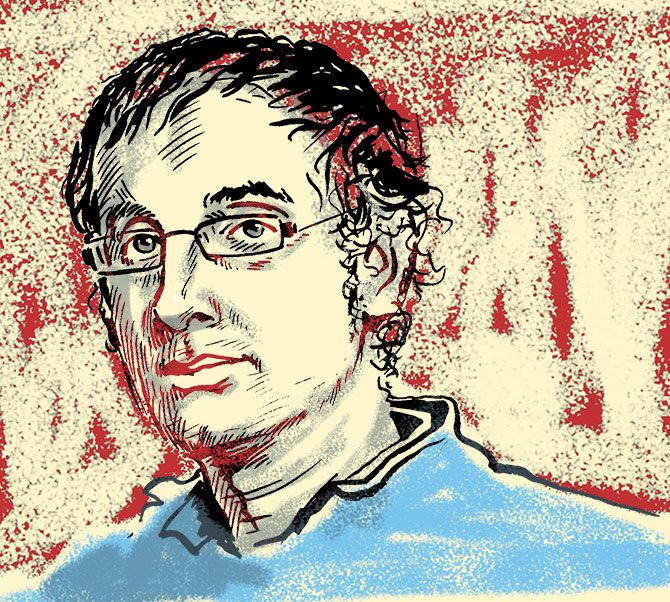 | « Back to article | Print this article |
Devangshu Datta walks you into the mind of the winner of the Fields Medal, considered by pure mathematicians as the equivalent of the Nobel Prize.
Illustration: Dominic Xavier/Rediff.com

Mathematics is a young person's game.
There is speculation that the brain's neural pathways become less plastic over time, limiting the insights of older people.
Whatever the reason, the most path-breaking work in maths and physics (which is essentially applied maths), has been done by people under 40. The discipline is studded with prodigies.
But even by mathematical standards, Akshay Venkatesh is unusually prodigious.
The newly minted Fields medallist emigrated from Delhi to Perth at the age of two, or rather, his parents did.
He joined the bachelor's course in mathematics at the University of Western Australia when he was 13. By then, he had already won several medals at Maths Olympiads.
Venkatesh graduated at 16 and completed his PhD from Princeton University at 20.
After holding a post-doctoral position at MIT, he was a Clay Research Follow at the Clay Mathematics Institute.
The 36 year old is currently a professor at Stanford, and intends to transfer to the Institute of Advanced Studies at Princeton in a few months.
The Australian citizen has won a multitude of awards, including The Infosys Prize, The Ramanujam Prize and the Ostrowski. But the Fields Medal is considered the equivalent of the Nobel in terms of prestige for pure mathematicians, even though it carries only a nominal cash award of CAD$15,000.
The prize was created by Canadian mathematician John Charles Fields in 1936, and is handed out only to mathematicians under 40.
Early in his incredible career, Venkatesh believed that his PhD thesis was 'not very original' and briefly contemplated moving out of the realm of pure mathematics into applications like machine learning.
His mother Svetha Venkatesh teaches computer science at Deakin University, and is a pioneer in big data analysis. So it perhaps wasn't that surprising.
Despite his lack of self-belief, Venkatesh soon started to produce paper after important paper, often in collaboration with different mathematicians.
This is where a very important facet of his genius became apparent.
Maths encompasses a wide variety of sub-disciplines, and few mathematicians are experts at more than one or two areas. Venkatesh, however, has always been an avid reader, delving into entirely different areas of mathematics purely for entertainment.
According to his professors, collaborators and college roommates, he is capable of picking up a complex topic (not necessarily maths) from scratch, teaching himself, and swiftly developing insights that can be applied to other branches of maths.
This has led to the multiple collaborations with domain experts.
His Fields citation is for the 'synthesis of analytic number theory, homogeneous dynamics, topology, and representation theory'. That's tying four different branches of mathematics together.
One crude way to explain this is to say that Venkatesh looked at shapes and numbers using, among other things, techniques developed to study chaotic systems (weather patterns and stock prices), to relate shapes within number systems.
His earlier work includes deep insights into L-Functions -- variations of the notorious Zeta Function that lies at the heart of mathematics's most famous unsolved riddle, the Riemann Hypothesis.
Currently, Venkatesh is doing what he calls 'speculative work' in the Langlands Program on the relationship between shapes seen in number theory (for example, X^2 + Y^2 =1 gives a circle) and topology (the study of odd physical shapes that can be twisted and 'glued' together).
Venkatesh is married to musicologist Sarah Paden, and the proud father of two young girls.
In one of his recent interviews, he said it was a lot harder to physically tie up their hair than to do a mathematical analysis of pigtails!